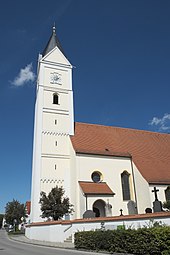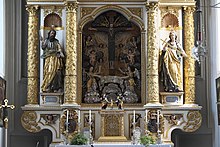St. Wilgefortis (Neufahrn near Freising)
The old Catholic parish and pilgrimage church of St. Wilgefortis in Neufahrn near Freising , a municipality in the Upper Bavarian district of Freising , is essentially a Gothic church building from the 15th century, which was converted to Baroque style at the beginning of the 18th century . The most important piece of equipment in the church is the so-called Wilgefortis cross , a Romanesque crucifix that was the destination of a popular pilgrimage for over 200 years. The church belongs to the parish of St. Franziskus and to the deanery Weihenstephan in the Archdiocese of Munich and Freising . The building is on the list of protected architectural monuments in Bavaria.
Patronage
The church was originally dedicated to the apostle Bartholomäus , later to the Holy Spirit and then to St. Wilgefortis , also known as holy sorrow . In 1921 it became the Holy Spirit Church again, and since 1991 it has been consecrated to the two patrons of the Holy Cross and Saint Wilgefortis .
history
The Neufahrner Church is already mentioned in writing at the beginning of the 9th century. From 1354 to 1803 the church was owned by the Weihenstephan Benedictine Abbey . The present church was built in the middle of the 15th century, the originally five-story tower probably dates from the early 14th century. The consecration, which took place in 1499, probably took place after a renovation in which the church was given a Gothic rib vault . Around 1580 there was a fire that also damaged the Wilgefortis cross. In the course of the Baroque renovation of the interior, the vault ribs were cut off in 1715 and the vault was decorated with stucco . In the middle of the 19th century the tower was increased.
Pilgrimage to St. Wilgefortis
At the beginning of the 17th century the pilgrimage to St. Wilgefortis developed. The object of worship was a wooden cross with a figure of Christ in the style of the Volto Santo of Lucca , which was said to have miraculous effects. The sculpture from the 12th century probably came to Neufahrn from the Weihenstephan monastery church at the end of the 14th century. The Gothic picture panels in the choir and in the Florian chapel describe how woodcutters discovered the miraculous image on the Isar while drifting against the direction of the current, how they salvaged it and transported it on an ox cart to the Neufahrn church, where all kinds of miracles are said to have happened. Around 1700, the bearded figure, clad in a long robe and with a golden crown on its head, was reinterpreted as Saint Wilgefortis. According to legend, she was a king's daughter, whose face was disfigured by a beard with God's help to save her from marrying a persecutor of Christians. Her father then had her nailed to the cross like Christ. With the secularization in 1803 the pilgrimage came to a standstill.
architecture
Exterior construction
The tower, structured by cornices and blind arches, stands in front of the west facade . The sign on the south side of the nave still has its Gothic ribbed vault. Next to the sacristy , the Florian chapel opens onto the nave. The strongly drawn-in choir is structured by stepped buttresses protruding far on the outside.
inner space
The single nave nave is divided into three bays , the choir has a front bay and has a five-eighth end . The fluted pilasters on the nave walls and in the choir are decorated with capitals . The vaults in the choir and nave were covered in 1715 with a rich stucco decoration made of flowers, fruits and garlands, which is attributed to Nikolaus Liechtenfurtner from Freising. The windows are surrounded by tendrils. The frescoes were probably created by Lucas Zais in the same year and depict scenes from the Wilgefortis legend. They were partially painted over in 1933; the main fresco depicting the glorification of St. Wilgefortis was renewed in 1991.
Furnishing
- The three-storey high altar was created in 1660/61 in the style of the transition from Renaissance to Baroque and was framed in white in 1715. The altar and the carved figures are attributed to Tobias Schmid from Freising, a student of Philipp Dirr . The miraculous image, the Wilgefortis cross with the Romanesque figure of Christ, which is dated to the 12th century, was integrated in the center of the altar. The crucifix is framed by baroque putti , the apostle Bartholomäus (left), the original patron of the Neufahrner church, and Maria Magdalena (right) stand to the side. The excerpt shows the Coronation of Mary by the Trinity , the side figures depict two Freising bishops with their attributes , St. Korbinian with the bear at his feet and St. Lantpert von Freising with a lamb. The altar is crowned by two angels, in the middle stands the Archangel Michael with the soul scales. On the tabernacle , in the change of the church year, the group of figures of Holy Change (Mary, Joseph and the baby Jesus) from the 17th century can be seen, a baroque baby Jesus (at Christmas time) or the risen Christ (between Easter and Pentecost).
- The two side altars also date from the 17th century. The left side altar is dedicated to the holy clan . Saint Anne holds the baby Jesus in her arms, next to her stands Mary as a young girl. St. Joseph is on the left and St. Joachim on the right . In the middle of the altar extract, John the Baptist is depicted as a child with a cross and a lamb at his feet, next to him his parents, St. Elizabeth and St. Zacharias , who is holding a tablet with the inscription "John is his name" holds. Because of his doubts that he would have a son in old age, Zacharias had been beaten with mute punishment and had to write the name he wanted to give his son on a blackboard. The small figure of Mary on the altar hall is a replica of the Altöttinger Madonna from the 17th century.
- On the right side altar, St. Catherine is depicted with her attribute, the wheel, in the middle , St. Ursula on the left and St. Barbara on the right . The excerpt shows the diocese saint Sigismund , the apostle John and Saint Rochus of Montpellier .
- Delicate figures of the twelve apostles with Mary and Jesus from the 18th century are attached above the choir stalls on the north choir wall.
- Seven Gothic panel paintings from 1527 depict scenes from the legend of the Wilgefortis Cross, its arrival in Neufahrn and the first miracles it is said to have caused. Four pictures hang in the choir, three panels in the Florian chapel.
- The pulpit is a work from the second half of the 17th century. The four evangelists are depicted on the pulpit . The sound cover is crowned by a magnificent structure and a cross with St. Wilgefortis. At the feet of the saint sits a small figure of a violin player who recalls the legend according to which Saint Wilgefortis is said to have thrown one of her golden shoes to a poor musician who had played before her. The violinist was then suspected of theft and sentenced to death. When he was allowed to play again in front of the saint, as was his last wish, she threw him the second shoe in front of everyone.
- Next to the pulpit hangs a colored, Gothic wooden relief depicting the death of the Virgin , which is dated around 1525.
- A rosary Madonna from around 1660 hangs above the entrance to the St. Florian Chapel .
- Like the figures on the high altar, the Scourge Savior in the Florian Chapel is attributed to Tobias Schmid.
- The figure of St. Leonhard on the south side of the nave is dated around 1600.
- Opposite St. Leonhard, on the north side of the nave, there is a pietà on a console decorated with a pine nut .
- The painted stations of the cross on the nave walls were created in 1736.
literature
- Georg Dehio : Handbook of the German art monuments. Bayern IV: Munich and Upper Bavaria. 2nd edition, Deutscher Kunstverlag, Munich 2002, ISBN 3-422-03010-7 , pp. 867–868.
- Ernest Lang: Churches of the parish Neufahrn near Freising. (= Kleine Kunstführer Nr. 457), 4th edition, Verlag Schnell and Steiner, Regensburg 2018, ISBN 978-3-7954-4283-5 , pp. 2–20.
Web links
- Birgit Grundner: Legends and Myths: The Princess Beard. Article in the Freising local edition of the Süddeutsche Zeitung , online version from January 9, 2017
- Ernest Lang: The old parish and pilgrimage church of Sankt Wilgefortis. Parish of St. Franziskus Neufahrn
Individual evidence
- ↑ Pilgrimage Church of St. Wilgefortis. District of Freising
- ↑ Ernest Lang: The old parish and pilgrimage church Sankt Wilgefortis. Parish of St. Franziskus Neufahrn
- ↑ List of monuments for Neufahrn (PDF) at the Bavarian State Office for Monument Preservation, monument number D-1-78-145-1 .
- ↑ Katharina Boll: The legend of the woman on the cross: Theological considerations on the Upper German text tradition. In: art and saelde. Verlag Königshausen and Neumann, Würzburg 2011, ISBN 978-3-8260-4605-6 , pp. 161–177.
Coordinates: 48 ° 18 ′ 41.4 " N , 11 ° 39 ′ 51.7" E










